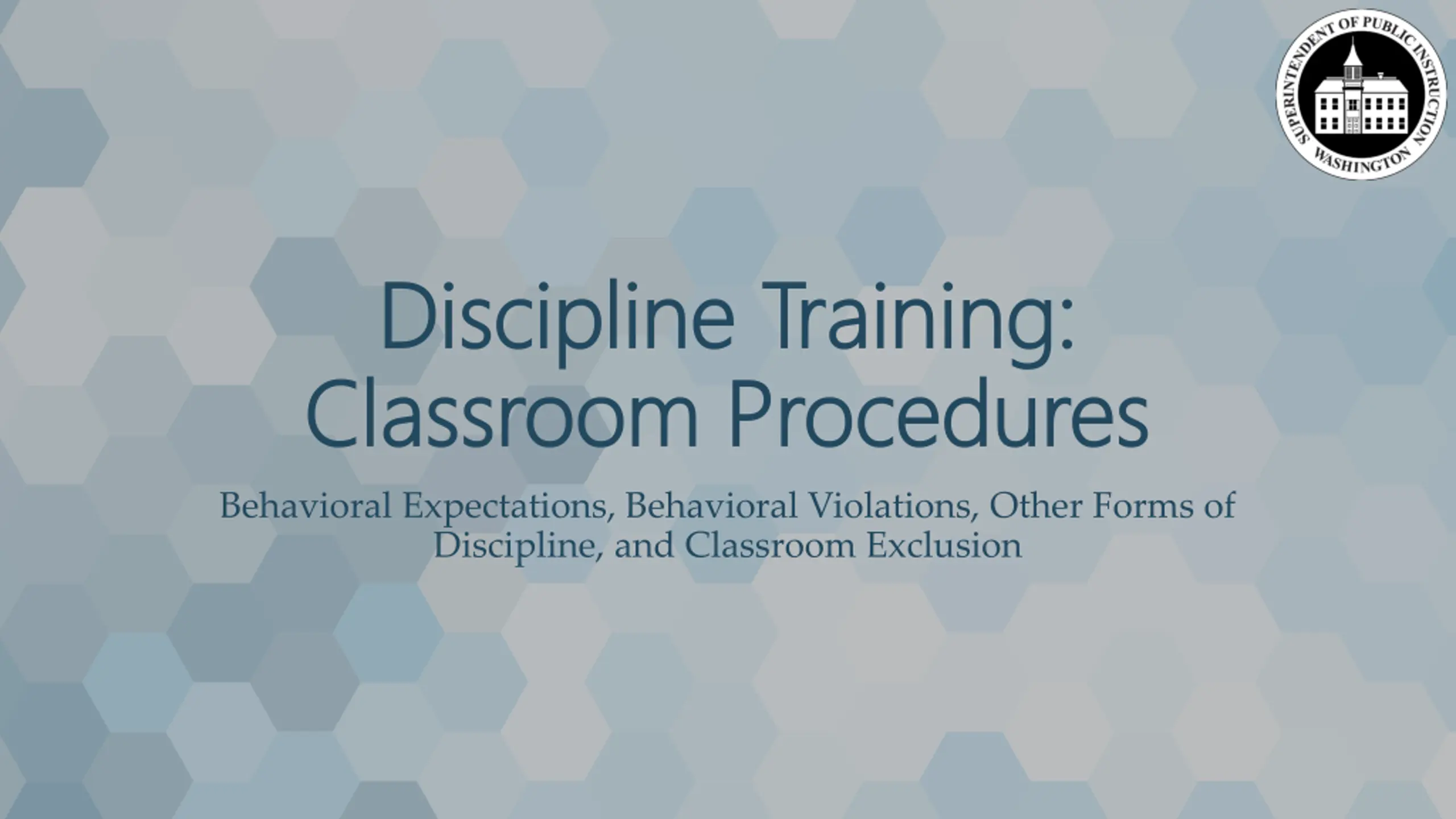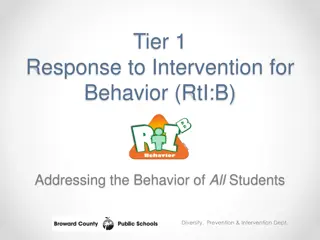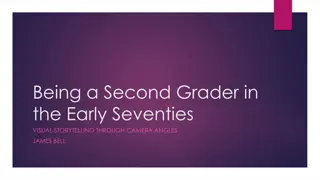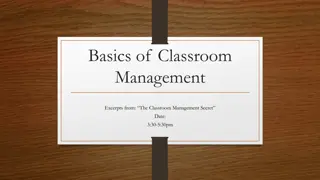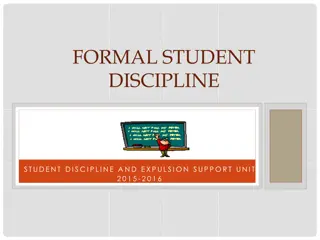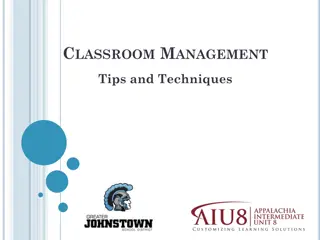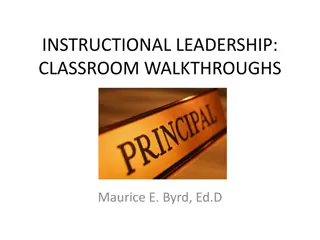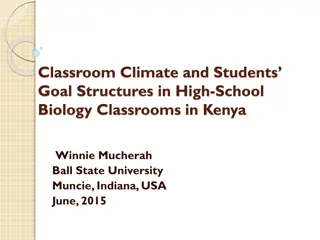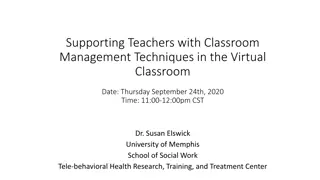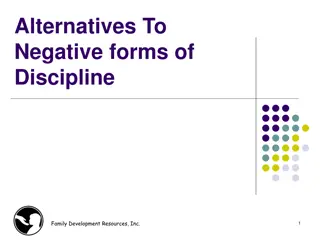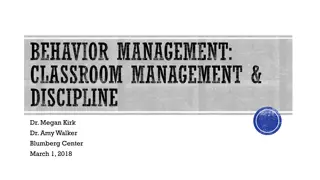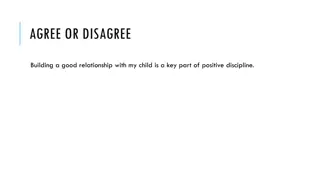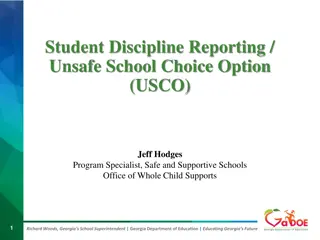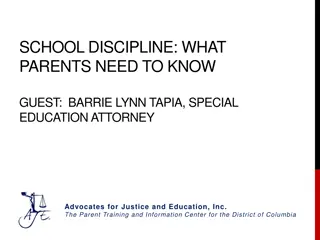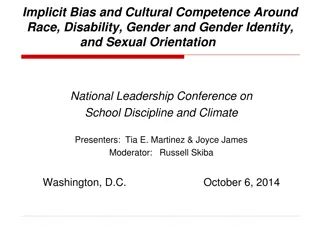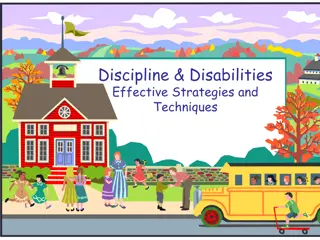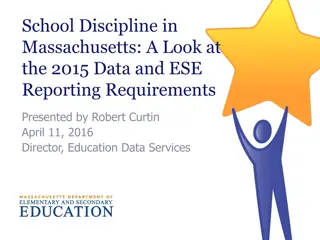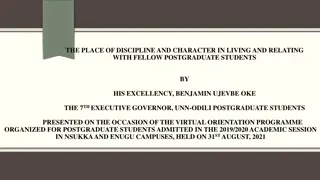Effective Classroom Discipline Training
Learn about classroom procedures, behavioral expectations, violations, and exclusion strategies to maintain a positive learning environment for all students. Enhance your disciplinary practices with legal compliance and equity considerations.
Download Presentation

Please find below an Image/Link to download the presentation.
The content on the website is provided AS IS for your information and personal use only. It may not be sold, licensed, or shared on other websites without obtaining consent from the author.If you encounter any issues during the download, it is possible that the publisher has removed the file from their server.
You are allowed to download the files provided on this website for personal or commercial use, subject to the condition that they are used lawfully. All files are the property of their respective owners.
The content on the website is provided AS IS for your information and personal use only. It may not be sold, licensed, or shared on other websites without obtaining consent from the author.
E N D
Presentation Transcript
Discipline Training: Discipline Training: Classroom Procedures Classroom Procedures Behavioral Expectations, Behavioral Violations, Other Forms of Discipline, and Classroom Exclusion
Webinar Q&A Protocols Please submit questions in writing through the question log Please keep questions related to the webinar content OSPI staff and guests will not be able to answer questions about specific scenarios, students, or experiences OSPI staff is readily available to provide technical assistance following the webinar There will be a 5 minute break between the presentation and Q&A portions of the webinar OSPI staff will review and group questions for Q&A portion
OSPI Equity Statement Each student, family, and community possesses strengths and cultural knowledge that benefit their peers, educators, and schools. Ensuring educational equity: Goes beyond equality; it requires education leaders to examine the ways current policies and practices result in disparate outcomes for our students of color, students living in poverty, students receiving special education and English Learner services, students who identify as LGBTQ+, and highly mobile student populations. Requires education leaders to develop an understanding of historical contexts; engage students, families, and community representatives as partners in decision- making; and actively dismantle systemic barriers, replacing them with policies and practices that ensure all students have access to the instruction and support they need to succeed in our schools. https://www.k12.wa.us/about-ospi/about-agency
Discipline Training: Discipline Training: Classroom Procedures Classroom Procedures Behavioral Expectations, Behavioral Violations, Other Forms of Discipline, and Classroom Exclusion
Legal Disclaimer These materials constitute OSPI s interpretation of discipline policies and procedures under chapter 28A.600 RCW and chapter 392-400 WAC and are provided to support school districts understanding of their obligations under these laws. The information in these materials is subject to change based on future legal and policy changes. Before taking action based on the information in these materials, please review state and federal laws and regulations or consult with legal counsel familiar with your particular circumstances. These materials are intended for informational purposes only and do not constitute legal advice.
Training Considerations OSPI discipline training contains some content related to Multi-Tiered System of Supports (MTSS), Positive Behavioral Interventions and Supports (PBIS), restorative justice practices, culturally responsive teaching, family engagement, trauma-informed approaches, function-based thinking, classroom management strategies, etc. However, effective implementation of MTSS/PBIS frameworks or any particular best practices and strategies, interventions, or approaches should include ongoing and job- embedded professional learning. OSPI discipline training can be used to support such efforts, but the content is not comprehensive. Therefore, participants should identify areas where school and district staff could benefit from additional training and supplemental resources.
Learning Objectives Identify strategies for adopting positive behavioral expectations and clearly defined behavioral violations Integrate best practices and strategies into district, school, and classroom discipline policies and procedures Describe differential selection and equitable approaches to reducing disproportionality in discipline List the conditions for using classroom exclusion and related procedures
Classroom Decision-Making Differential Selection School discipline processes generally begin with an office referral, most often made by a classroom teacher. (Anyon, et al., 2014, p. 380) Disparities in discipline begin at the classroom level Primarily minor and subjective categories (e.g. defiance and disrespect), instead of major and objective categories (e.g. firearms possession) Racial/ethnic disparities persist even when accounting for student characteristics that include family income and likelihood of misbehavior (Anyon, et al., 2014; Gregory, Skiba, & Noguera, 2010)
The Discipline Continuum Selection (Teacher)
Administrative Decision-Making Differential Processing There is tremendous local flexibility in the types of infractions that move forward from the classroom to the office and in the types of consequences issued by administrators. (Gregory, Skiba, & Noguera, 2010, p. 63) Following a classroom exclusion, school administrators are primarily responsible for deciding and assigning consequences Subjective discipline situations have the greatest potential for bias in processing, as administrators' behavioral expectations like those of teachers' and students' are shaped by perception, culture, and context (Anyon, et al., 2014, p. 380) (Anyon, et al., 2014; Gregory, Skiba, & Noguera, 2010)
The Discipline Continuum Selection (Teacher) Processing (Principal)
Behavioral Expectations Behavioral Expectations
Proactive Supports in Regular Educational Settings Continuum of supports for students and staff Screening for additional supports (academic, social-emotional, and behavioral) Intervention programs (push-in, pull-out, or extended learning opportunities) Progress monitoring to determine whether the intervention should be changed or modified Diagnostic data to align interventions with students strengths and needs Clear entrance and exit criteria for intervention programs Implementation fidelity and program evaluation
Purpose of Discipline Rules One of the purposes of OSPI discipline regulations is to ensure that school districts in Washington: Administer discipline in ways that respond to the needs and strengths of students, support students in meeting behavioral expectations, and keep students in the classroom to the maximum extent possible; See WAC 392-400-010(5)
Defining Regular Educational Setting The particular classroom, instructional or activity area in which a student is provided the instructional program of basic education as required under WA law. Universal Design for Learning (UDL) Differentiated instruction Supplemental instruction and services Academic standards and rigor Behavioral expectations
Behavioral Expectations: Reflection Make a list of behavioral expectations and examples that are common in your school setting. CC0 Public Domain via Pixabay.com
Behavioral Expectations: Positive with Examples Positive behaviors that are well- defined for students and staff: Schools should develop common language around positively stated behavioral expectations. School staff should teach, model, and reinforce desired behaviors. Negative practices that are identified for change can be reframed positively. Examples that are identified for specific school settings: Schools should identify common locations where behavioral expectations can be demonstrated and observed. Schools should then provide examples of what positive behaviors look like in various school settings.
Behavioral Expectations: Feedback Transitioning from reprimanding negative behavior: To acknowledging positive behavior: You are being very disrespectful. Correct your behavior now and stop interrupting me. You are listening very attentively. Thanks for actively engaging in the lesson. (Approach: shaming, punitive, deterring) (Approach: acknowledging, positive, reinforcing)
Establishing Behavioral Expectations The establishment of classroom norms and behavioral expectations should: Promote inclusive and reflective processes through culturally responsive decision-making that respects the cultural values of the surrounding community and diverse students funds of knowledge Establish high standards for all students that serve a legitimate purpose within the school setting (i.e. school safety) without devaluing family norms and values in different cultures and home settings (Gonz lez, Moll, & Amanti, 2005; Green, et al., 2015; Gregory, Skiba, & Mediratta, 2017; Leverson, Smith, McIntosh, Rose, & Pinkelman, 2019)
Behavioral Expectations Activity Look at your list of behavioral expectations and examples. Label each expectation as either positive (P) or negative (N) and each example as either specific (S) or general (G). Are there more behavioral expectations on your list that are framed negatively than positively? Why? Are the examples on your list more general or specific to a variety of common school settings (i.e. classroom, hallway, bathroom, cafeteria, etc.) Are the behavioral expectations known by students, families and staff? Are they modeled consistently by all staff? If not, why and under what conditions would they be modeled? Are the behavioral expectations primarily representative of dominant white cultural values? Do they serve a legitimate purpose within the school settings? Are there any behavioral expectations or specific examples that have not been explicitly identified and taught?
Behavioral Expectations: School Environments Behavioral expectations must be taught: Embedded in existing curriculum Delivered through ongoing explicit instruction Re-taught through instructional interventions Inclusive of the English language levels of all learners to ensure equitable and shared understandings Behavioral expectations should be visible: Student handbooks and communication with families Posters and visual displays throughout the building
Teaching Behavioral Expectations Students need to be taught context-specific behavioral expectations within school settings. All school staff need to model and actively teach behavioral expectations to: Build fluency among students, parents, and staff Evaluate student s understanding Give students opportunities to demonstrate skills Reinforce staff and student agreement about expectations
Behavioral Expectations: Practical Example Keep It Clean by A&M Consolidated High School. https://www.youtube.com/watch?v=SILZ82YEpcM
Content Break Drink Think Digest Discuss Journal Kinesthetic activity
Behavioral Violations Behavioral Violations
Behavioral Violation WAC 392-400-025(1) Behavioral violation" means a student's behavior that violates a school district's discipline policy adopted under WAC 392-400-110. In accordance with WAC 392-400-100, district policies and procedures must: (a) Clearly state the types of behaviors for which discipline, including suspension and expulsion, may be administered; (b) Have a real and substantial relationship to the lawful maintenance and operation of the school district including, but not limited to, the preservation of the health and safety of students and employees and the preservation of an educational process that is conducive to learning;
Defining Behavioral Violations Behaviors that constitute a behavioral violation should be operationally defined: Specific: clearly defined in detail Observable: action that can be seen Measurable: action that can be counted or timed (Borgmeier, C., 2018; Green, et al., 2015)
Categorizing Behavioral Violations Behavioral violations should be organized into minor and major categories or levels of severity with distinct procedures for responding to each: Minor Handled at the classroom level May not result in classroom exclusion or suspension Major Referred to a school administrator May result in an administrative decision to suspend or expel (Green, et al., 2015)
Behavioral Expectations and Violations Not meeting behavioral expectations Behavioral violation
Behavioral Violations and Implicit Bias Implicit bias can play a role in interpreting student behaviors: Subjectively defined behavioral violations Assumptions about students family environment or norms Labeling (media stereotypes, tracking, program eligibility, etc.) Educator over-attention (expect certain misbehavior) Educator under-attention (minimalize certain misbehavior) Cultural mismatch Low expectations Developmentally unrealistic expectations (Bal, Schrader, Afacan, & Mawene, 2016; Bradshaw, Mitchell, O Brennan, & Leaf, 2010; Gilliam, et al., 2016; Hatt, 2012; Morris & Perry, 2017; Smolkowski, Girvan, McIntosh, Nese, & Horner, 2016)
Classroom Practices: Protective Factors Increased positive adult interactions High academic expectations Engaging instruction Self-regulation techniques to mitigate impact of educator biases Opportunities to respond Behavioral expectations explicitly taught and modeled Culturally responsive teaching Commitment to racial equity Continuum of developmentally and age-appropriate responses Trauma-informed strategies that foster resiliency Classroom routines and environmental arrangements (Cook, et al., 2018; Green, et al., 2015; Larson, Pas, Bradshaw, Rosenberg, & Day-Vines, 2018)
Adult Interpretations of Student Behavior School suspensions are an adult behavior Rosemarie Allen TEDxTalks https://www.youtube.com/watch?v=f8nkcRMZKV4&feature=youtu.be
Content Break Drink Think Digest Discuss Journal Kinesthetic activity
Equitable Systems & Data Equitable Systems & Data- - Based Decision Based Decision- -Making Making
Identifying Inequities in School Discipline Setting Event Antecedent Behavior Consequence Poor instruction and few positive adult interactions Directives and perceptions of neglect, injustice, or illegitimacy Resistance, deviance, attention-seeking, or disengagement Involuntary compliance and exclusionary discipline (Curran, 2016; McIntosh, Girvan, Horner, & Smolkowski, 2014; McIntosh & Payno, 2018; Perry & Morris, 2014; Way, 2011)
Increasing Equity in School Discipline Setting Event Antecedent Behavior Consequence Engaging instruction and frequent positive adult interactions Opportunities to respond and perception of fairness Pro-social skills and human error Positive feedback and instructional discipline (Curran, 2016; McIntosh, Girvan, Horner, & Smolkowski, 2014; McIntosh & Payno, 2018; Perry & Morris, 2014; Way, 2011)
Data Collection Tools and Strategies Data Collection Tools Antecedent-Behavior-Consequence (ABC) forms Incident Reports Office Discipline Referral (ODR) Time Out of Class form or Missed Instruction log Data Collection Strategies Consistent entry of school enrollment and discipline data by student race/ethnicity, gender, etc. Standardized definitions and data collection methods Format to use data for principal and parent notice
Data Analysis Strategies Patterns of disproportionality to identify differential selection that is occurring early in the discipline continuum (behavior types, times/days/months, location, setting events, triggers, possible motivations, referring staff) Disaggregated by student subgroups (demographics and characteristics) Disaggregated by behavior types (severity level and categories) Cross-tabulated at the student level (demographics and characteristics) and school level (e.g. behavior type and location) Integrated analysis to identify correlations between student academic and behavioral outcomes
Vulnerable Decision Points Contextual variables that increase the likelihood of implicit bias influencing discipline decision-making: Subjective behavior (ambiguously defined, adult-rated level of severity, etc.) School setting (classrooms, academic tasks, etc.) Time of day (stress, hunger, fatigue, etc.) Unfamiliar with student (in-group bias, etc.) (McIntosh, Girvan, Horner, & Smolkowski, 2014; McIntosh & Payno, 2018; Smolkowski, Girvan, McIntosh, Nese, & Horner, 2016)
Vulnerable Decision Points Promising strategies for neutralizing implicit bias: Delay decision (interrupt potential escalation and model calm behavior) Reframe the situation (assume student is communicating a need, etc.) Self-awareness (recognition of internal state and personal biases) Self-regulate (internal check, breathing techniques, etc.) (McIntosh, Girvan, Horner, & Smolkowski, 2014; McIntosh & Payno, 2018; Smolkowski, Girvan, McIntosh, Nese, & Horner, 2016)
Exclusionary Adult Behaviors Exclusionary practices are adult behaviors that: May provide temporary relief Do not support students in meeting behavioral expectations May incentivize repeated use of exclusionary practices Educators that overly rely on exclusionary practices: Are capable of learning replacement behaviors Should receive support through professional learning opportunities, additional classroom or school personnel, coaching, etc. (Cook, et al., 2018; Gregory, 2016; Larson, Pas, Bradshaw, Rosenberg, & Day-Vines, 2018; Okonofua, Paunesku, & Walton, 2016)
Vulnerable Decision Points & Classroom Exclusion Analysis WHAT problem behaviors are associated with disproportionate classroom exclusions? WHERE are there disproportionate classroom exclusions (i.e., for what locations)? WHEN are there disproportionate classroom exclusions (i.e., for what times of day/days of the week/months of the school year)? WHAT MOTIVATIONS are associated with disproportionate classroom exclusions (e.g., for what perceived functions of problem behavior)? WHO is issuing disproportionate classroom exclusions (e.g., for what staff)? (Adapted from McIntosh, Barnes, Eliason, & Morris, 2014 p. 16)
Equitable Learning Environments Example Why We Need Trauma-Sensitive Schools by Trauma Sensitive Schools https://www.youtube.com/watch?v=vyQdOLl6d2c
Content Break Drink Think Digest Discuss Journal Kinesthetic activity
Other Forms of Discipline Other Forms of Discipline and Classroom Exclusion and Classroom Exclusion
Classroom Exclusion: Definition WAC 392-400-025 defines classroom exclusion as the exclusion of a student from a classroom or instructional or activity area for behavioral violations and provides that [c]lassroom exclusion does not include actions that result in missed instruction for a brief duration when: (a) a teacher or other school personnel attempts other forms of discipline to support the student in meeting behavioral expectations, and (b) the student remains under the supervision of the teacher or other school personnel during such brief duration.
Other Forms of Discipline Definition "Other forms of discipline" refers to actions used in response to behavioral violations, which may involve the use of best practices and strategies included in the state menu for behavior. See WAC 392-400-025(9) Identify other forms of discipline. See WAC 392-400-110(1)(e) Attempt other forms of discipline. See WAC 392-400-330(2)
Classroom Best Practices and Strategies Teach, model, and reinforce behavioral expectations Parent communication Active supervision Correct misbehaviors in private Increase opportunities to respond Restorative practices Environmental adjustments Collaborative problem-solving Function-based thinking/assessment
Classroom Exclusion: Teacher Authority & RCW 28A.600.020(2) Teachers and principals must develop shared understandings, establish agreed upon protocols, and receive ongoing professional learning related to: District and building definitions of behavioral violations considered disruptive enough to the educational process that a classroom exclusion would be allowable District and building policies and procedures for first attempting one or more other forms of discipline District and building procedures for the principal and teacher to confer following a classroom exclusion
Classroom Exclusion Procedures Conditions and Limitations Procedures Behavioral Violation Other Forms of Discipline Classroom Exclusion Principal Notice Parent Notice Grievance Procedure District and Building Policy Teacher Principal or Designee Process for principal and teachers to confer regarding building disciplinary standards (e.g. classroom-managed / office-managed) RCW 28A.400.110; RCW 28A.600.020(3) Process for principal and teacher to confer regarding the classroom exclusion and returning the student to class RCW 28A.600.020(2)
